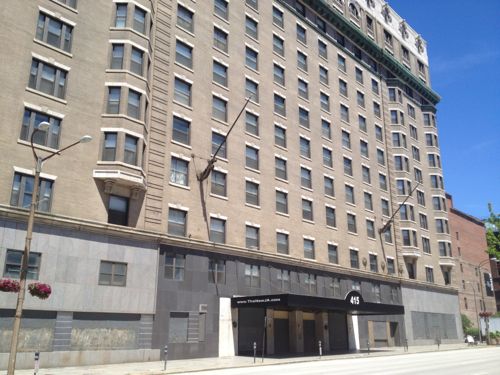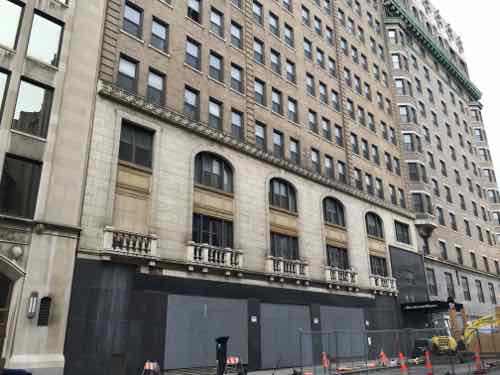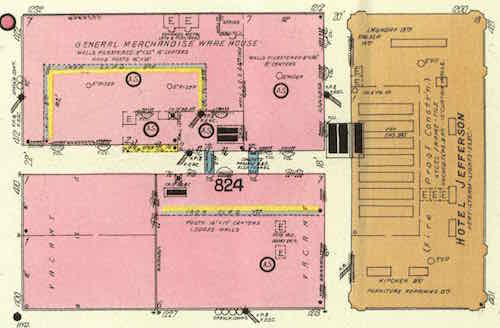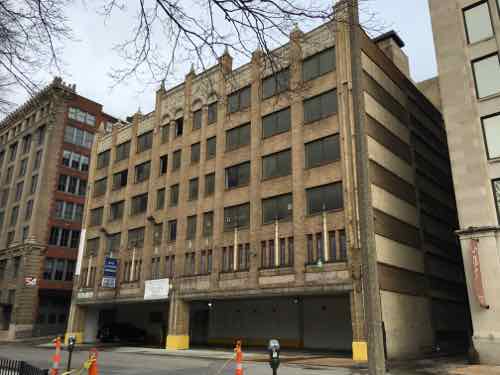Long-Vacant Jefferson Arms May Finally Be Occupied Again
News broke Wednesday of a developer having the Jefferson Arms, originally known as The Hotel Jefferson, under contract:
Mike Sarimsakci, founder and president of real estate developer Alterra International, has the building under contract for an undisclosed price.
His plans for the Jefferson Arms were unclear but could be similar to Alterra’s hotel-and-apartment redevelopment of an old Butler Brothers warehouse in Dallas, officials said.
Real estate investor David Jump, who owns the building, was unavailable for comment. (Jefferson Arms renovation possible — Post-Dispatch)
While this is exciting news, it isn’t the first time in the last decade the building was to be renovated.

Pyramid Construction, before going under in 2008, had bought the building — in 2007 Pyramid kicked out the existing residents (seniors) to prepare for renovation. This quote picks up the story:
After it was foreclosed on in 2009, the Jefferson Arms has been at the center of a four-year-long legal dispute involving [Barry] Cohen and the Federal National Mortgage Association.
In March 2011, a partnership led by Cohen filed a federal lawsuit in St. Louis against EF&A Funding, alleging an agent at EF&A gave Cohen misleading information when he refinanced a loan on the Jefferson Arms.
Cohen’s partnership, Affordable Communities of Missouri, also sued Federal National Mortgage Association, better known as mortgage giant Fannie Mae, seeking to recoup a $500,000 loan penalty paid after Cohen sold the Jefferson Arms building to Steffen’s company. EF&A later settled with the partnership, but Fannie Mae remained as a defendant. February 2015: Jefferson Arms shows complexities of downtown dealmaking — Post-Dispatch
In 2012/13 it looked again like something might happen:
Not so fast on writing off the plan by McGowan Brothers Development to rehab the empty Jefferson Arms in downtown St. Louis.
Owner David Jump has the building up for sale, but developer Tim McGowan said Friday that his company was still seeking federal New Markets Tax Credits to help finance the apartment redevelopment of the huge building at 415 North Tucker Boulevard.
McGowan said he hoped to find out in the first week of April if the Jefferson Arms project gets the federal tax credit this year. The project got shut out in last year’s allocation. (February 2013: McGowan Brothers still pursuing Jefferson Arms project — Post-Dispatch)
Hopefully this time the building will be renovated and reoccupied — I’m cautiously optimistic.
Like other large downtown buildings, such as the Arcade/Wright, the Jefferson Arms was built in phases — adding to the complexity of renovating for use in the 21st century. To understand the building one of the best sources is the 2003 nomination to the National Register of Historic Places. The following are selected quotes:
Page 29:
The Hotel Jefferson, located at 415 North Tucker Boulevard in downtown St. Louis, is a thirteen-story steel frame hotel building and six-story reinforced concrete parking garage, all clad in Revival style veneers of brick and terra cotta. The east half of the hotel was built in 1904 and fronts 220 feet along the west side of Tucker Boulevard (once Twelfth Street) and 100 feet along St. Charles Street to the north, and Locust Street to the south. In 1928, the building expanded to the west another 100 feet. Also erected in 1928, the Jefferson Plaza Garage (measuring 145 feet by 110 feet) at the southeast corner of St. Charles and North Thirteenth Streets, joins the west elevation of the 1928 addition. The storefront level of both the original hotel building and the addition was altered circa 1953 when portions of the terra cotta veneer were replaced with grey and black granite. Metal panels were also installed to wrap around the columns and border the new entrance, which was moved back to its 1904 location at the center of the east (primary) elevation. The south elevation entrance was re-faced with black granite. Overall, the exterior facades of the hotel and garage buildings retain a strong sense of their historic identity as excellent examples of a large, early 20* century hotel in an urban environment. This is conveyed through the integrity ofmaterials and design, and the hotel’s setting and relationship to Tucker Boulevard, St. Louis’ widest street. Typical of numerous buildings in the central business district, exterior alterations to the hotel are confined to the lower two stories and the attic story in relationship to cornice modifications. Easily offsetting these modifications, the bulk of the Hotel Jefferson’s massive and imposing facades remain virtually unaltered and intact. Although the original layout ofthe guest rooms on the upper floors was changed when the rooms were remodeled into apartment units in 1976-77, the plan ofthe characteristic public spaces on the lower floors continues to reflect historic hotel functions. On the ground floor, these include the lobby, dining room, coffee shop, and storefronts. On the mezzanine level, two large banquet rooms retain significant Revival style detailing as well as plan.


Page 35
Ground was broken in mid-March, 1903, by Westlake Construction Co. and by May two shifts of crews working sixteen hours a day had pushed construction forward sufficiently to create a “steel forest” on Twelfth Street. The city’s broadest street, spanning a width of 150 feet, Twelfth (Tucker) had long been envisioned as a grand boulevard of monumental buildings likened to “what Unden der Linden is to Berlin, the show street of the city, because of its amplitude.”However, there was little evidence of the street’s potential before the tum-of-the-century. The completion of the new thirteen-story hotel commanding a full blockface on Twelfth thus promised at last to make the thoroughfare, “an ideal urban picture, the centerpiece of St.Louis as a metropolis…especially at night with electric lights reflected from damp pavements.”
Page 36
The hotel proper opened for guests on April 29 [1904], the eve of opening day of the fair. Registered dignitaries included the official delegation ofmembers ofthe U. S. Senate which, along with delegates from the House, represented the federal government at the opening ceremonies in the absence of President Theodore Roosevelt who telegraphically signaled the opening from his office in the White House. Suites ofrooms were also reserved for large state delegations from Ohio and Pennsylvania, and for numerous foreign noblemen. During fair year, the hotel served as headquarters for the Democratic National Convention as well as various other conventions, associations, and clubs.9
In 1916, the Hotel Jefferson again hosted the Democratic National Convention, this time leading to the second term of President Woodrow Wilson. The hotel’s sumptuous lobby,dining and cafe rooms also became favorite nightspots for local citizens. The opening in 1910 of the neighboring Shubert Theatre (later called the Jefferson Shubert) located across Locust Street in the Union Electric Building (demolished) attracted the after-theater crowd. A visiting traveler’s description in 1916 evokes something of the character of the hotel then: “we went over to the Jefferson to see society there … at midnight things begin to wake up at the Jefferson. Dozensoflimousinesunloadgladragsfullofhumanitywhowanttoeatand drink after the theaters. They used to employ artists to sing and dance for the guests but now, a space in the dining room is reserved and a part of the lobby is railed off so the guests themselves can dance between courses…They seem to have a lovely time and I wished I could be in ‘that element’.”
Page 38
The Jefferson Plaza Garage (Photos # 5, 6; Figs.16, 17, 18), erected in 1928 at the same time as the hotel annex, featured a facade of unusual architectural interest for garages of the period. Most garage facades of the 1920s (and later) in St. Louis displayed either structural concrete or standard red brick facing with little attempt at art. The materials ofthe primary (west) facade (along with the brick side elevations) ofthe Jefferson Plaza Garage matched the hotel annex’s buffbrick and cream terra cotta materials while respectfully addressing significant neighboring buildings on North Thirteenth Street such as the Shell Building (1925), Leopold Eidlitz’s Christ Church Cathedral (1859-67, NHL), and Cass Gilbert’s St. Louis Public Library (1910). The architects of record for the garage, Gill & Jackson (St. Louis), were assisted by W.J.Knight&Co.(St.Louis), consulting engineers specializing in reinforced concrete construction.
The garage’s utilitarian interior of exposed reinforced concrete construction exhibits a plan based on Fernand d’Humy’s 1919 patent for short,easy-graderampsandstaggered,split-levelfloors(Fig.16).The d’Humy patent, transferred to the Ramp Buildings Corporation (New York) which licensed use ofthe ramp system, became the standard design feature ofthe modern multi-level car park; the new building type offered quick and easy car access, an improvement over elevator garages ofthe 1920s. The six-story Jefferson Plaza Garage, originally accommodating 600 cars, was financed and built by St. Louisan William King who purchased the building lot from Hotel Jefferson interests in 1927 with the intent of collaborating with the hotel plans for expansion and upgraded service. While construction was in progress it was announced that the hotel and garage would be connected at the second story “so that tourists can drive directly to the garage and have no inconvenience from their luggage.” In 1924, William King, the former general manager of the Automobile Club of Missouri, had begun construction of the first of a series of four downtown commercial garages (all razed except the Jefferson Plaza) “in the hope ofrelieving parking and traffic congestion.”

The nomination is great reading and it has great photos. You can see see recent images of the abandoned ballroom here.
I like that Alterra International is actually international — based in Turkey — with projects worldwide. The founding partner seems well-educated:
Mr. Sarimsakci holds a Masters’ degree from Stanford University’s Structural Engineering Department, and received his bachelor of science degree in Civil Engineering from Colorado State University. He is fluent in English, Russian, and Turkish.
They’re finishing up converting the Butler Brothers warehouse in Dallas into a hotel & apartments — maybe we can interest them in taking on our Butler Brothers warehouse?
— Steve Patterson
Can anyone tell me if there is anyway to get in to take pictures before any changes are made? I’m a huge history fan and it will be a shame to lose any of the original work with documentation of some kind. I also dabble in photography as a hobby but not professionally. I just feel like it would be a shame to lose any piece of this history. I have no objections to one of the developers representatives accompanying me. I just love restoring old homes, furniture, etc and if they cannot be saved then at least documenting them. I know that there have been other pictures done in the past but it would mean a lot to me. Who would I contact? Any information would be greatly appreciated!!